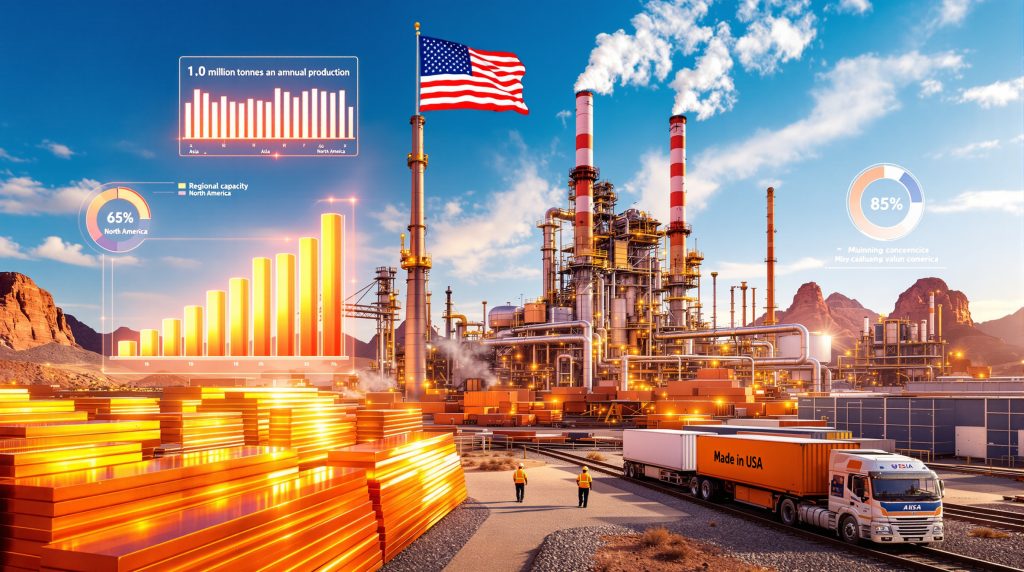America's Copper Processing Revival: Strategic Investments Drive Domestic Smelting Expansion
The United States finds itself at a pivotal moment in copper processing, where strategic imperatives intersect with industrial necessity to create unprecedented investment opportunities in domestic smelting capacity. Despite global treatment and refining charges languishing at multi-year lows and widespread overcapacity in Asian markets, America is witnessing a remarkable surge in US copper smelting projects that could fundamentally transform the nation's position in international metal processing markets.
This transformation reflects more than simple economic calculations. While traditional smelting margins face severe compression from global oversupply, particularly in China, Indonesia, and India, American copper processing initiatives operate under distinctly different strategic frameworks that prioritise supply chain security, regulatory compliance, and long-term industrial resilience over immediate profitability metrics. Furthermore, these developments align with broader copper price predictions that suggest strengthening fundamentals.
The Strategic Foundation of America's Processing Gap
America's copper industry operates within a paradoxical framework where the nation ranks among the world's top five copper producers yet remains heavily dependent on foreign processing facilities. The United States mines approximately 1.06 million tonnes of copper annually, yet more than half of this valuable material exits the country as unprocessed concentrate, primarily bound for Asian refineries where it undergoes transformation before returning to American markets as finished cathode products.
This circular supply chain creates multiple inefficiencies and vulnerabilities that extend beyond simple economics. American mining operations face volatile treatment and refining charges, substantial freight costs, and exposure to geopolitical disruptions that could severely impact domestic copper availability during critical periods. Additionally, the tariff impact on copper adds another layer of complexity to these supply chain considerations.
Current US Copper Processing Statistics:
- Domestic mine production: 1.06 million tonnes annually
- Refined copper production: Just over 400,000 tonnes
- Processing gap: Approximately 600,000+ tonnes exported for overseas refining
- Strategic vulnerability: Over 50% of domestic concentrate processed abroad
The existing processing infrastructure consists of only two operational primary copper smelters: Rio Tinto's Kennecott facility and Freeport-McMoRan's Miami operation. These facilities collectively produce slightly more than 400,000 tonnes of refined copper annually, representing less than 40% of domestic mining output and creating a substantial strategic processing deficit.
Revolutionary Projects Reshaping US Copper Smelting Capacity
Grupo México's Hayden Smelter Renaissance
The most immediate opportunity for expanding American copper processing capacity lies with Grupo México's comprehensive evaluation of its shuttered Hayden smelter in Arizona. This facility, which has remained dormant since 2019, represents a potential cornerstone of America's copper processing revival due to its existing infrastructure and strategic location within the southwestern copper mining corridor.
The Hayden modernisation initiative would incorporate cutting-edge emission control technologies and contemporary processing systems designed to exceed current environmental standards while restoring substantial domestic refining capacity. Unlike greenfield developments, the Hayden restart benefits from existing infrastructure, established utility connections, and proven concentrate sourcing relationships that significantly reduce both timeline and capital requirements.
Industry analysis suggests that modernised existing facilities face considerably shorter permitting timelines compared to entirely new constructions, making Hayden potentially the fastest pathway to meaningful capacity expansion. However, this development must consider the broader global copper supply forecast and its implications for market dynamics.
Falcon Copper's Groundbreaking Greenfield Initiative
Perhaps the most ambitious undertaking in American copper processing involves Falcon Copper's evaluation of a $2 billion integrated smelter and refinery complex in the western United States. This project has attracted significant international attention, particularly from Japanese industrial partners who could provide both advanced technology and guaranteed off-take agreements for refined copper products.
The Falcon Copper development represents the first major greenfield US copper smelting project proposal in decades, incorporating modern process technologies and environmental controls from initial design phases rather than retrofitting older facilities. A recent US copper investment insight highlighted potential Japanese participation as both technology suppliers and long-term product purchasers, creating a strategic partnership that addresses financing, technical expertise, and market access challenges simultaneously.
Falcon Copper Project Specifications:
- Total investment: $2 billion estimated capital requirement
- International partnerships: Japanese technology and off-take agreements
- Strategic significance: First major greenfield US smelter in multiple decades
- Integrated design: Combined smelting and refining operations
The integrated smelter and refinery design suggests coordinated primary processing and refined product production within a single facility, potentially maximising operational efficiency and reducing intermediate transportation costs compared to separate processing stages.
Optimisation Programs at Existing Operations
America's two operational primary copper smelters are simultaneously pursuing significant upgrade and expansion initiatives designed to extend facility life, improve recovery rates, and enhance environmental performance. These optimisation programs represent parallel development tracks that complement both restart and greenfield projects.
Rio Tinto's Kennecott Enhancement Program:
Rio Tinto's Kennecott operations focus on life extension and recovery optimisation through advanced automation and sophisticated process control systems. The enhancement program emphasises improved environmental performance through upgraded emission reduction capabilities while maximising copper recovery from processed concentrates.
Freeport-McMoRan's Miami Facility Expansion:
Freeport-McMoRan's Miami facility optimisation centres on incremental capacity expansion through integration of alternative copper recovery technologies. The program emphasises improved energy efficiency and comprehensive waste reduction while exploring innovative processing methods for complex concentrate types.
Additionally, Freeport is investigating advanced technology applications to enhance copper recovery from existing leach operations, with approximately half of the company's leach stockpiles located at the Morenci facility in Arizona. This alternative approach could increase domestic copper production without traditional smelter construction.
Policy Framework Supporting Copper Processing Expansion
Critical Minerals Designation and Federal Incentives
The Trump administration's treatment of copper as a critical mineral has fundamentally altered the economic landscape for domestic processing projects. Copper's inclusion on the proposed US critical minerals list frames the metal as essential to energy security and grid modernisation, unlocking access to various federal support mechanisms previously unavailable to the industry.
This critical minerals classification enables US copper smelting projects to qualify for substantial tax credits, comprehensive loan guarantee programs, and additional federal incentives specifically designed to encourage reshoring of strategic processing capabilities. The designation reflects recognition that domestic copper processing capacity represents a national security asset rather than simply an industrial facility.
Federal Support Mechanisms Available:
| Support Type | Description | Strategic Impact |
|---|---|---|
| Tax Credits | Investment and production incentives | Improved project economics |
| Loan Guarantees | Federal backing for project financing | Reduced capital costs |
| Regulatory Flexibility | Extended compliance timelines | Accelerated development |
| Strategic Classification | Critical mineral status | Priority treatment |
Environmental Regulatory Modifications
The Environmental Protection Agency's recent rule adjustments have provided copper smelters with meaningful compliance flexibility by extending certain emissions deadlines by two years. This regulatory modification moved previously mandated 2024 compliance requirements to 2026, creating breathing room for facility upgrades and new project development.
This modest but significant reprieve could accelerate projects like Hayden and Falcon, where environmental permitting timelines can extend for years and create substantial project development bottlenecks. Consequently, the extended compliance timeline allows developers to incorporate advanced environmental controls during construction rather than rushing to meet immediate deadlines with potentially suboptimal solutions.
Economic Drivers Beyond Traditional Smelting Margins
Strategic Value Versus Market Economics
While global copper smelting faces severe margin compression due to overcapacity, particularly in Asian markets, US copper smelting projects operate under fundamentally different economic assumptions that extend beyond traditional profitability metrics. The strategic value of domestic processing creates economic justifications that transcend immediate market conditions.
Current spot treatment and refining charges have reached record lows, creating challenging operating conditions for global smelters dependent solely on processing margins. However, American projects benefit from unique cost structures and potential premium pricing for domestically processed copper, particularly for applications requiring verified supply chain provenance and domestic content compliance.
Economic Advantage Analysis:
| Factor | Global Market Challenge | US Strategic Advantage |
|---|---|---|
| Treatment Charges | Record low margins | Premium pricing potential |
| Transportation | High international freight | Reduced logistics expenses |
| Regulatory Environment | Inconsistent standards | Predictable compliance framework |
| Strategic Premium | Limited applicability | Supply chain security value |
| Domestic Content | Not relevant | Federal program qualification |
Treatment Charge Dynamics and Regional Arbitrage
The global copper smelting industry currently faces unprecedented margin pressure as treatment charges have collapsed to multi-year lows, reflecting oversupply conditions in major processing centres. This situation creates challenging economics for facilities dependent solely on traditional smelting margins for profitability. Moreover, this trend aligns with evolving copper demand and investment patterns worldwide.
However, US projects operate within different economic frameworks that incorporate strategic premiums, reduced transportation costs, and qualification for domestic content requirements that create alternative revenue streams beyond pure processing margins. American copper processing facilities can potentially command premium pricing for strategic supply chain security and regulatory compliance benefits.
The regional arbitrage opportunity exists because while global smelting capacity is abundant, it remains concentrated in regions that may not align with long-term strategic interests of American industrial consumers, defence contractors, and infrastructure developers requiring secure copper supply chains.
Secondary Processing and Recycling Infrastructure Integration
Advanced Recycling Capacity Development
America's expanding network of secondary copper processing facilities represents a complementary development track that enhances primary smelting expansion by reducing dependence on both imported refined copper and primary ore processing. These facilities recover copper from industrial scrap, electronic waste, and end-of-life products using increasingly sophisticated technologies.
Advanced sorting technologies, automated processing systems, and improved metallurgical techniques are enhancing the efficiency and economics of copper recycling operations throughout the United States. This technological evolution supports higher recovery rates and superior product quality from secondary sources, creating additional domestic copper supply without requiring new mining operations.
Technology Integration in Secondary Processing
Modern secondary copper processing incorporates automated material identification, precision sorting systems, and optimised metallurgical recovery processes that maximise copper yield from complex waste streams. These technological advances are particularly important for processing electronic waste, which contains high copper concentrations but requires sophisticated separation techniques.
The integration of secondary processing with primary smelting operations creates opportunities for comprehensive copper recovery from both primary concentrates and recycled materials within shared infrastructure, potentially improving overall facility economics and environmental performance.
Implementation Challenges and Risk Factors
Capital Investment and Financing Requirements
Modern copper smelters require extraordinary capital investments, typically ranging from $1.8 to $2.5 billion for greenfield facilities incorporating contemporary environmental controls and process technologies. These substantial financial requirements reflect the complexity of integrating advanced sulfur capture systems, acid production facilities, and sophisticated emission control equipment from initial construction phases.
The financing challenge extends beyond simple capital availability to include long-term operational risk assessment, technology selection, and market positioning strategies that justify massive upfront investments against uncertain future operating conditions. Successful project development requires comprehensive financial structures combining federal incentives, private investment, and strategic partnerships.
Concentrate Supply and Quality Considerations
While the United States produces sufficient copper concentrate to theoretically support additional domestic smelting capacity, practical implementation faces significant challenges related to grade variations, blending requirements, and concentrate quality specifications. Not all domestic concentrate is suitable for every smelting process, potentially requiring additional sourcing, transportation, or blending operations.
Grade and blending constraints create operational complexities that extend beyond simple tonnage calculations to encompass metallurgical compatibility, processing optimisation, and quality control requirements that affect both operational efficiency and product specifications. These technical considerations significantly impact facility design, operating procedures, and economic performance.
Workforce Development and Technical Expertise
The American copper smelting industry requires specialised technical expertise that has diminished significantly over decades of capacity decline and facility closures. Successful project implementation necessitates comprehensive workforce development programs, knowledge transfer from international operations, and extensive training initiatives to rebuild domestic technical capabilities.
The skills gap encompasses multiple technical disciplines including metallurgy, process control, environmental management, and facility maintenance that require years of development and hands-on experience. This workforce challenge represents a critical bottleneck that could limit project success regardless of capital availability or regulatory support.
Global Context and Competitive Positioning
International Capacity Distribution Analysis
Global copper smelting capacity remains heavily concentrated in Asia, particularly China, Indonesia, and India, which collectively control approximately 65% of world processing capacity. This geographic concentration creates both strategic opportunities and competitive challenges for American market development initiatives.
The concentration of processing capacity in Asian markets reflects decades of investment in low-cost, high-volume facilities that benefit from proximity to major copper mines and integrated industrial supply chains. However, this concentration also creates potential vulnerabilities for Western copper consumers dependent on Asian processing for refined copper supplies.
Regional Processing Capacity Analysis:
| Region | Capacity Share | Strategic Characteristics | Competitive Advantages |
|---|---|---|---|
| Asia | ~65% | Cost leadership, scale economies | Low processing costs, established infrastructure |
| North America | ~8% | Strategic proximity, regulatory stability | Supply chain security, domestic content |
| South America | ~15% | Resource proximity, regional integration | Mine-to-market integration |
| Europe/Other | ~12% | Technology leadership, environmental standards | Innovation, sustainability |
Technology and Environmental Standards Leadership
US copper smelting projects are implementing significantly more advanced environmental controls and process technologies compared to many global competitors, reflecting stringent domestic regulatory requirements and strategic emphasis on sustainable operations. While this approach increases capital costs, it positions American facilities as leaders in sustainable copper processing.
Advanced environmental performance potentially qualifies American smelters for premium market segments, including customers requiring verified environmental compliance, reduced carbon footprint, or specific sustainability certifications that may command pricing premiums in increasingly environmentally conscious markets.
Development Timeline and Investment Expectations
Near-term Progress Opportunities (2025-2027)
The most immediate advancement in US copper processing capacity will likely emerge from existing facility upgrades and potential restart of the Hayden smelter. These projects benefit from shorter permitting timelines and can leverage existing infrastructure, making them significantly more feasible within near-term development windows.
Optimisation programs at Kennecott and Miami facilities represent the lowest-risk pathway to incremental capacity expansion, requiring modest capital investments while providing immediate operational improvements and environmental performance enhancements.
Medium-term Expansion Phase (2028-2032)
Greenfield projects like Falcon Copper's proposed facility require substantially longer development periods encompassing comprehensive environmental impact assessments, extensive community engagement processes, complex financing arrangements, and detailed engineering development. Success within this timeframe depends heavily on sustained policy support and favourable market conditions.
The medium-term phase will likely determine whether current policy initiatives and market conditions can support the massive capital investments required for new smelter construction, or whether regulatory and economic challenges will limit expansion to incremental improvements at existing facilities.
Long-term Industry Transformation (2032 and Beyond)
Successful completion of current projects could catalyse additional investment in American copper processing infrastructure, potentially including fully integrated mining and smelting operations that maximise domestic value capture from American copper resources while minimising dependence on international processing.
Long-term success could position the United States as a significant player in global refined copper markets, fundamentally altering international trade patterns and reducing Western dependence on Asian processing capacity for strategic copper supplies.
Market Impact and Strategic Implications
Supply Chain Reconfiguration Potential
Successful development of substantial US copper smelting capacity could reduce American dependence on Asian processing facilities, potentially altering global trade flows, treatment charge dynamics, and regional market structures. This shift might particularly benefit North and South American mining operations seeking processing alternatives to Asian facilities. According to US copper smelting capacity analysis, there's significant potential for reshoring these critical operations.
Enhanced domestic processing capability could create alternative market dynamics where Western Hemisphere copper producers gain access to competitive processing options, potentially improving their negotiating positions and reducing exposure to Asian market volatility. Furthermore, these developments could impact broader copper mining trends in the United States.
National Security and Strategic Mineral Implications
Expanded domestic copper processing capability directly supports broader US strategic mineral security objectives by reducing vulnerability to supply disruptions and providing greater control over critical material supply chains essential for defence applications, infrastructure development, and energy transition technologies.
The strategic implications extend beyond simple supply security to encompass technological independence, industrial base preservation, and long-term competitive positioning in industries increasingly dependent on secure copper supply chains for advanced manufacturing and defence applications.
Industry Analysis and Future Outlook
The convergence of policy support, strategic necessity, and technological advancement creates unprecedented opportunities for US copper smelting expansion despite challenging global market conditions. While traditional smelting economics face significant headwinds, the strategic value proposition for domestic processing capability provides compelling justification for continued investment and development.
Success will ultimately depend on maintaining consistent policy support, securing adequate long-term financing, and developing the technical expertise necessary to operate world-class copper processing facilities that can compete effectively in global markets while serving strategic domestic objectives.
The next decade represents a critical period that will likely determine whether America can successfully address its copper processing gap and establish itself as a major force in global refined copper markets, or whether current initiatives will encounter the same economic and regulatory obstacles that have historically constrained US smelting capacity development.
Current market analysis suggests that refined copper demand in the United States is expected to double by 2035, driven primarily by energy transition requirements, infrastructure modernisation, and advanced manufacturing growth. This demand trajectory provides strong fundamental support for expanded domestic processing capacity beyond strategic considerations.
"This analysis is based on current market conditions and policy frameworks as of late 2025. Copper smelting projects involve substantial capital risks, extended development timelines, and exposure to volatile commodity markets. Investment decisions should incorporate comprehensive due diligence, independent technical assessment, and careful consideration of regulatory and market risks that could materially affect project outcomes."
Interested in Copper Processing Investment Opportunities?
Discovery Alert's proprietary Discovery IQ model delivers real-time notifications on significant copper and mineral discoveries across the ASX, empowering subscribers to identify actionable investment opportunities in the expanding mineral processing sector ahead of broader market recognition. Explore how major mineral discoveries have historically generated substantial returns by visiting Discovery Alert's dedicated discoveries page and begin your 30-day free trial today to position yourself strategically in this evolving market.




